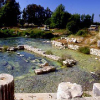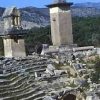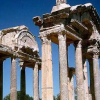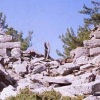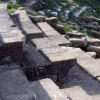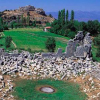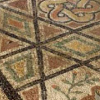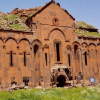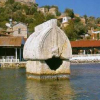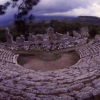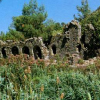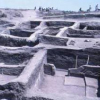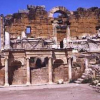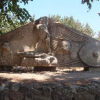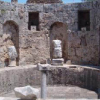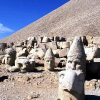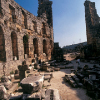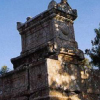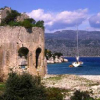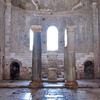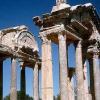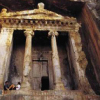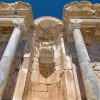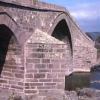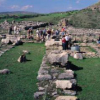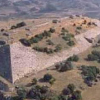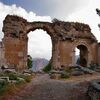
Adana Anavarza This site which was known as Caesarea or Anazarbus during the times of the Roman Empire, is 28 km to the south of the Kozan District of the Adana province. The small village built just outside the antique city walls is Dilekkaya. We have practically no knowledge of the history of the city before the Roman Empire era. It was named Caesarea by Emperor Augustus who visited the city in 19 B.C. and it started to be known as "Caesarea near Anazarbus".
Anavarza did not show any significant presence during the first two centuries of the Roman Empire period and was shadowed by Tarsus, the capital of the Cilicia state. Tarsus managed to survive to the present times but lost the majority of its historical monuments. The city Isos, which the Roman Emperor Septimius Severus entered with Pescennius Niger and sided with Severus during the power struggle, was rewarded when the Emperor won his battle in 192 A.D. and became the sole ruler of the empire, started to enjoy its days of glory. In the period 204-205 AD Cilicia became the metropolis of the Isaura and Licaonia states. In 206 AD Anavarza, like other Cilician cities, was captured by the Sasani King Shapur. Anavarza which was destroyed by Balbinos of Isaura in the 4th century A.D became capital of Cilicia Secunda (Cilicia of the Plain) which was established during the reign of Theodosius II. The city was badly hit with an earthquake in 525, but was later restored by the Emperor Justinianus, and renamed Justiniopolis. In 561 it experienced a second earthquake disaster and in the 6th century was hit with a major plague epidemic.
During the chaotic centuries which followed the rise of the Islam, Anazarbus remained as a buffer zone between the Arabs and the Byzantines and frequently changed hands between the two sides. In 796, Harun el Reşid re-built the city and Caliph Mutacvakil (846-861) rebuilt the Sis castle and carried out active work at Anazarbus. His name is mentioned in an inscription piece in Kufi language found at the ruins of tower located outside the west gate. In the 10th century, when Aynı Zarba was once more on the brink of ruin, Hamdanid al-Dawla turned it into a fortified settlement by spending the tremendous sum of three million dirham. The city then became the focus of interest of the Byzantines again and during the 964 campaign which ended in victory, Nicephorus Phocas took over Anazarbus along with several important fortifications including Tarsus and Mopsuhestia. In the 11th century, the Armenians whose capital was conquered by Alpaslan were driven towards the southwest under the pressure of theSeljuk Turks and established a kingdom in the Taurus region. Later on, they slowly progressed towards the Cilician plain, and there chose Anazarbus as their capital until the year 1100. Except for a gap of 7 years, when the Byzantines again gained control under the rule of John Commeneus between 1137-1144, the city remained as a capital for almost for a whole century. In 1184 Tarsus, and then Sis, became the capital. Despite the fact that Anazarbus remained as an important fortification, the city which was built lower down, on the flat plan eventually started to be destroyed. It was finally totally ruined when the Memlüks destroyed the Little Armenian Kingdom in 1375, and this antique settlement has never been used again since.
The ruins in Anavarza consist of a 1500 metre long city wall with 20 bastions, four entrances, a colonnaded street, and the ruins of a bath house and a church. Important works also include the theatre and the stadium outside the city walls, aqueducts, rock tombs, the necropolises in the western side of the city, the antique road which was constructed by splitting the rock mass and the pooled mosaics which are conserved in situ (the mosaic of the sea goddess Thetas from the 3rd century AD), the victory arc with three entrances, which is the only example of its kind in the Adana region and the castle from the middle ages on the hill which rises like an island in the centre of the plain.
About fifty metres to the north-east of the stadium, the rock is separated with a man-made fissure. The Moslems of the region consider this as the crack cut by Hz. Ali and tell a legend about how the son-in-law of the Prophet pulled out his sword and made a crack in the rocks for himself and his horse when he was being pursued by the enemy. Leaving this legend aside, the fissure seems to be opened to allow for the road which went from Anazarbus to Flaviopolis (Kadirli) and Hieropolis (Kastabala during the Byzantine Period). The passage is 250 metres long and its width changes between 4-15 metres. On both sides of the road, the rock faces reach up to 50 metres. For a traveller emerging into the sunshine towards the east from the deep shadows of the passage, to see one of the inscriptions on the face of the high rocks would no doubt will be a rather sentimental experience.
"Hence, we shall not be afraid, Should the earth move and should the Mountains be moved to the middle of the sea. Should the waters rise and roar and should the mountains tremble with the rising waters"
The colonnaded street running North-South, starts with this three-spanned arch. Anavarza has witnessed numerous earthquakes (including the severe earthquake of 1945) but the Victory Arch managed to remain standing, at least partially, up to our time. It is a three-arched passage with six Corinthian column capitals from black granite on its south façade. There are statue niches on both sides of the main arch on the northern façade.
The amphitheatre, which was also the scene of performances with wild animals was a structure built completely with stones. It was apparently systematically looted (as was the case for many buildings) during the antique age to provide material for other buildings. Today, we have a sufficient amount of architraves, friezes, cornish blocks, column bodies, inscriptions and even Corinthian column capitals, which were used everywhere that give an idea about the splendour of the Anazarbus of the Antique ages.
The castle can be defined in three sections. The barracks section including the first wall and a church; a three storey tower built on the flat rock between the two walls; the second wall and an adjacent complex of rooms it, storage areas and water tanks it encloses.
Antalya - Limyra
Believed to have been in existence since the 5th century, Limyra is still in existence despite a massive earthquake that struck in the mid 19th century and despite its evacuation in the 7th and 9th centuries, following Arab invasions. The city composes of three section; the acropolis, areas of settlement, and...
Antalya - Xanthos
Founded on the Xanthos river basin, Xanthos is the biggest and the most ancient city of Lycia. Having remained independent until the invasions of the Persians in 4292 B.C., Xanthos tried hard to defend against the invasions. However, upon realizing that they had been defeated, the people of Xanthos first murdered their women, then commited suicide...
Aydın-Aphrodisias
This unique ancient city was named after Aphrodite, the goddess of beauty and love. The origins of the city could be traced back to the late Neolithic ages. Following the rise of the Roman supremacy in the region during the 2nd century BC, a holy attribute had been added to the city. Aphrodisias is located 38 km south of Nazilli, in the Geyre...
Bodrum - Pedasa
Pedesa is four kilometres away from Bodrum, on the top of a hill covered with trees. As there is no road, you can only get there on foot. For those who are interested, this trip will give them a pleasant hike and great satisfaction. The ruins can be seen on the top of the hill, within a circle of 150 metres in diameter. The remains are generally...
Bodrum - Stratonikeia
The archaic city of Stratonikeia lies in the borders of the Eskihisar Village on Yatağan - Milas highway that is 6 - 7 km to the west of Yatağan District of Muğla.
The city was established in the 3rd century B.C. The Syrian King Seleukos I, gave his wife Stratonike to his son Antiokhos. Antiokhos established a city in the name of Stratonike,...
Cappadocia - Historical Places
Göreme
Göreme, in which there are many fairy chimneys and churches, is declared as an open air museum. Tokalı Church, the Priestesses and Priests Monastery, Saint Basil Chapel, Elmalı Church, Saint Barbara Chapel, Yılanlı (Saint Onuphrius) Church, Karanlık Church, Çarıklı Church, El Nazar Church, Saklı Church, Mother Mary (Kılıçlar...
Çeşme-Erythrai
Çeşme is a port of the ancient city, Erythrai, which was formerly known as Cyssus in ancient times. It was an important settlement area, in the 6th century BC. The city developed its trade by establishing relations with Egypt, Cyprus and western countries. The Erythrai Ancient City, excavated in (the village of) Cesme-Ildiri, composes of a...
Fethiye - Ancient Cities
Telmessos
Although the history of Fethiye, or with its ancient name Telmessos, which is the only center where settlement continued from its establishment on the Mediterranean shore band until today, goes back to 3,000 B.C., in accordance with some philological determinations, monuments that would verify those periods have not yet been...
Foça - Phokaia
The first natives of the Ancient Phokaia settlement in the place of today's Old Foça are the immigrants who came from the Phokis environs in Greece. Phokaia and its two ports had significantly grown and had become one of the most important harbor-cities of the ancient times. The city lost strength during the Persian rule in West Anatolia....
Izmir-Pergamon
Located 100 km from north of Izmir in the Bakırçay river basin, Bergama is one of the Turkey's oldest civilized settlements, which has been inhabited from pre-historic times through the Ionic, Roman and Byzantine civilizations. It has yielded archeological treasures whose importance is recognized world-wide.To the southwest of Bergama,...
Izmir - Ephesus
The Ruins of Ephesus
The first establishment of the antique City of Ephesus within the boundaries of Selçuk district of Izmir province dates back to 6000 BC, to the Neolithic age. During the researches and excavations, settlements from the Bronze Age and Hittite period were found in the tumuluses around Ephesus (pre-historic tumulus settlements)...
Kars- Ruins of Ani
The ancient citadel of Ani is situated on the barren plains above the Arpaçay Valley which separates Turkey and Armenia. The site is surrounded by an imposing fortified city wall, currently undergoing intensive restoration. This one time prominent city used to house over 100.000 citizens in it's hey-day. Once an important station on the ancient...
Kekova - Üçağız Village (Kekova)
Located between Kaş and Demre, it is an ancient, submerged city, 500m far from the Üçağız Village in the Mediterranean.
Kekova is the name of a region of fascinating islands, bays and ancient cities. Kekova has a rarely seen attraction: along the shore of the Island, a sunken city can be observed. The geological movements of the Island...
Kemer - Phaselis
It is found on the 58th km of Antalya - Finike road. It is also possible to reach Phaselis city by maritime lines, which are 15 km away from Kemer.
Being one of the eastern coastal cities of Lycia, Phaselis is one of the commercial cities of Hellenistic Age in the 6th century B.C. It becomes a bishop center during Roman Age. The eastern port of...
Kemer - Chimera Yanartaş
An interesting natural beauty, the mythological Yanartaş (Chimera), is located to the north of Olympus, on the upper side of the Çıralı Beach. The burning stones which are located about an hour's drive from Olympos have a mythological story behind them:
A divinely handsome young man named Bellerophon used to live in Argos, Greece....
Kemer - Olympos
Olympos is located on the Antalya-Finike road. In order to go to Olympos, it is necessary to make a turn from Ulupinar, when a sign pointing to the ruins can be seen. A narrow but beautiful road leads to the beach of Olympos. In order to get to the ruins, one must pass the creek and walk a little on a wide beach which will take you to the creek...
Konya-Çatalhöyük
Çatalhöyük is 10 kilometres east of Konya's Çumra Township. The tumulus is a hill with two flat areas with different altitudes. Because of these two elevations, it is called 'çatal,' meaning fork. Çatalhöyük was first discovered by J. Mellaart in 1958. There were a number of excavations here between 1961 and 1963, as well as in 1965. The...
Kuşadası-Kolophon and Notion
Kolophon (Değirmendere) is one of the twelve Ionic cities. Although it had a strong navy and cavalry force, because of the many wars that it had been involved in, it has been ruled by the forces of Lydia, Persia, Macedonia and even by sea pirates during certain periods of time.
When Kolophon was destroyed by Lysimakhos in 302 B.C., its...
Manisa-Sardis
Sardis is in the Aegean Region near Manisa and Izmir. Sardis was the capital of the famous Kingdom of Lydia, where the first coins in the world were minted. The Temple of Artemis by the Sart Stream dates back to the 4th century B.C. Sardis located at the starting point of the famous "King's Road" which extends towards the east, was an important...
Pamukkale - Hierapolis
The ancient city of Hierapolis, the original site of Pamukkale, was known as the Holy City in archaeological literature because of the abundance of temples and other religious structures in the area. Although there is limited information on the origin of the city, it is known that the city was founded by Eumenes II, who named it after Bergama's...
Pamukkale - Tripolis
Tripolis is 40 km north of the Denizli City center. It is established in the east of Yenicekent Town in the Buldan District, on the slopes between the Buyuk Menderes River and the town. It is connected to both Aegean shores and to Inner Anatolia and the Mediterranean with the Buyuk Menderes plain opening towards west. The city is 30 km to its peer...
Side - Ancient Side
Side, which is 7 km away from Manavgat, is an ancient settlement center. Side, which is mentioned by historians as being founded in 1405 A.D., had been ruled by the Lydians, Persians, Alexander The Great, Antiogonous and Ptolemaioses respectively, beginning from the second half of VIth century A.D. After 215 A.D., the city, which had improved...
Side - Seleukeia Lyrbe
To the northwest of Manavgat are the remains of the ancient city of Seleukeia, situated within the Şıhlar settlement area. The city is known to have been founded as a fortified acropolis town to be used as a final defence and protection site in the case of an attack on Side. Upon the capture of Side by pirates in the 2nd century B.C., a number...
Zeugma - Zeugma City
Location of Zeugma
Ancient Zeugma City is located in Belkis Village 10 km east from Nizip / Gaziantep, by the River Euphrates. Importance of this settlement which demonstrates an uninterrupted in habiting since prehistorical ages, is that it is one of the two points allowing the easiest passage across the River Euphrates. "Zeugma" already stands...
Adiyaman Nemrut
The Nemrut mountainside with the tumulus containing the tomb of King Antiochus of the Commagene Kingdom and several giant statues was inscribed to UNESCO's World Heritage List in 1987.
Nemrut Mountain is also known as the highest open-air museum in the world. With its enchanting statues standing ten metres high, and meters long inscriptions and...
Archaeological Site of Perge
Ancient Perge, one of the chief cities of Pamphylia
Perge, the long-established city of Pamphylia region, is located 18 km east of Antalya and 2 km north of Aksu Village. The Archaeological site of Perge has been excavated systemically by Istanbul University since 1946.Perge is famous by the fact that when Saint Paul started his journeys, he...
Aspendos
Aspendos Located in the second kilometer of the road turning to North at the 44th km. of Antalya - Alanya highway, Aspendos is famous for having the best-preserved Roman Theatre not only in Anatolia but also in the whole Mediterranean world. The city is situated over a flat hill nearby the Köprüçay (Eurymedon) River, one of the largest rivers...
Antalya Termessos
The ruined city of Termessos, lying 34km west of Antalya, in a rugged mountain valley, was founded by the Solymi people, from the interior of Anatolia. Among the important remains are, the 4200-seat theatre and the Roman stele that Augustus had built at the beginning of the first century AD. The Odeon and the covered meeting hall, has seating for...
Patara
Patara is found on the Kalkan-Fethiye road, nearly 10 km before Kalkan, and is located at the south. The colorful ceramics in the center of the city reveal that the history of the city reaches back to 5 B.C. Besides its being the birth place of St. Nicholas, it was one of the most important seaports during the times of Alexander the Great. Three...
Demre Myra
Demre was one of the most important cities of the Lycian civilisation. 25km west of Finike and 48km east of Kas, Demre was a place of settlement from the 5th century BC. The city was deserted in 9 A.D after the invasions of the Arabs. Rock tombs, theatres and the Church of St. Nicholas (said to be the original Santa Claus) are the most interesting...
Church of St. Nicholas
A larger church in the basilica style was built at the site of the first church, after it was ruined by an earthquake in 529. Peschlow assumes that two small residences on the southern part of the large wall and some parts of the northern wall are remnants of the original building. That church also suffered extensive damage through either an...
Aydin Aphrodisias
This unique ancient city was named after Aphrodite, the goddess of beauty and love. The origins of the city could be traced back to the late Neolithic ages. Following the rise of the Roman supremacy in the region during the 2nd century BC, a holy attribute had been added to the city. Aphrodisias is located 38 km south of Nazilli, in the Geyre...
Bodrum Telmissos
Telmissos is on the Bodrum-Turgutreis road, three kilometres past Ortakent. The site is in the village of Gürece, which is two kilometres before the turn for Gümüşlük, with the hill where the remains are to be found to the north of the main road. You can see remains of the Hellenistic period, mainly the towers of the city's walls. The...
Burdur Archaeological Site Of Sagalassos
The archaeological site of Sagalassos is located in southwest Turkey, near the present town of Ağlasun (Burdur province); roughly 110 km to the north of the well-known port and holiday resort of Antalya.
Large-scale excavations started in 1990.Most of the buildings in Sagalassos are from Hellenistic and Roman periods and well preserved, one of...
Assos
Assos, the famous teaching center of antiquity, is 87 km south of Çanakkale, in the Ayvacık County. Aristotle, Plato's most famous student, was invited to Assos, and spent over three years living and teaching there. He married the niece of Hermeia, founded a school of philosophy and conducted his early exploratory work in zoology, biology and...
Çorum-Alacahöyük
Alacahöyük is located 45 kilometres south of Çorum and 17 kilometres northwest of the Alaca township. The Alacahöyük village is 34 kilometres away from Boğazköy and 210 kilometres away from Ankara.
This tumulus, or mound, was first introduced to the world of science by W.C. Hamilton in 1835 and after that time, it became a place...
Hattusha Open-Air Museum
Hattusha, which was the capital of the Hittite Empire during antiquity, has been in the List of World Heritage since 1986 on cultural criteria. Hattusa on cultural criteria. Hattusha, which is an open-air archaeological museum, was founded around 1600 BC and became the focus of the arts and architecture of that time. Hattusha consists of two...
 Adana Anavarza This site which was known as Caesarea or Anazarbus during the times of the Roman Empire, is 28 km to the south of the Kozan District of the Adana province. The small village built just outside the antique city walls is Dilekkaya. We have practically no knowledge of the history of the city before the Roman Empire era. It was named Caesarea by Emperor Augustus who visited the city in 19 B.C. and it started to be known as "Caesarea near Anazarbus".
Adana Anavarza This site which was known as Caesarea or Anazarbus during the times of the Roman Empire, is 28 km to the south of the Kozan District of the Adana province. The small village built just outside the antique city walls is Dilekkaya. We have practically no knowledge of the history of the city before the Roman Empire era. It was named Caesarea by Emperor Augustus who visited the city in 19 B.C. and it started to be known as "Caesarea near Anazarbus".